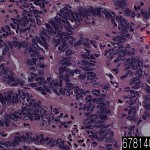| Product name | Colon adenocarcinoma WD |
| Cat. No. | 6781403A |
| No. of samples | 1 |
| Description | colon, adenocarcinoma Age/Sex : 48/F |
| Price | 197 EUR |
| 260 USD | |
| 170 GBP |
Product Related Literature
In addition, in colon cancer known as cancer or colon cancer of the colon, cancer, are in addition to uncontrolled growth of cells in the colon or rectum or is (colon). The genetic analysis of colorectal tumor essentially, the same genetically, indicating that it is a cancer. Typically, symptoms of colorectal cancer, would include rectal bleeding that is associated with changes in bowel habits and weight loss, sometimes anemia. As a fraction of the cases hereditary disease underlying are involved, colon most cancers can be attributed to age and lifestyle. Usually begins in the intestinal mucosa, and if not treated, the lower, which in turn can be converted into the muscular layer through the intestinal wall. Screening and is effective in reducing the risk of death from colon cancer, it is recommended starting at age 50, people will continue until 75 years old. Usually, colon cancer, which is localized be diagnosed by colonoscopy or S-shaped colonoscopy. Cancer in the wall of the intestine, while the cancer has spread widely in the body, curing is not cured typically often surgically, control, attention to the durability of the human using chemotherapy then , I have improved the quality of life. Colorectal cancer is a cancer that is most frequently diagnosed in the three largest in the world, but the developed countries is common it. About 60% of cases are diagnosed in developed countries. It is estimated that that all over the world in 2008, new cases of 1.23 million of colon cancer will be diagnosed clinically, it killed 608 million people.
Symptoms and signs of colon cancer is dependent on the location of the tumor in the colon whether it has spread to other parts of the body. Traditional signs include: worsening of constipation, blood in feces, reduction of gauge stool, loss of appetite, weight loss, and anyone over the age of 50 nausea and vomiting. Rectal bleeding while, anemia is a feature of the high risk of Lowel practice on if bleeding is usually in those over the age of 50. People with (ulcerative colitis and Crohn’s disease) and inflammatory bowel disease, the risk of colon cancer is high. Long human risk is greater than had worsening severity of inflammation and disease. It is recommended for prevention and high-risk group of these in colonoscopy and regular aspirin. People with inflammatory bowel disease, accounting for less than 2% of colon cancer cases every year. 2% is a colorectal cancer 8% in ’10 after 20 years in those with Crohn’s disease, 18% after 30 years. About 16 percent of developing colon cancer or precursor cancer and after 30 years in those with ulcerative colitis.
Those having a family history of primary more than two, the risk of increased two to three times the disease, which will be explained about 20% of the group of all cases. Number of genetic syndrome is associated with rate of colon cancer in high. The most common of these is (Lynch syndrome or HNPCC) hereditary non-polyposis colon cancer, which is present in about 3% of those with colon cancer. Syndrome of other highly relevant include: familial adenomatous polyposis and Gardner’s syndrome is the responsibility of one percent of the cases that are occurring almost always cancer (FAP) is. Most of the deaths from colorectal cancer that is associated with metastatic disease. Transition associated with cancer Colon, one – the gene that appears to contribute to the likelihood of metastatic disease, I was isolated. This is a transcription factor that affects the expression of hepatocyte growth factor. This gene is linked to a distributed invasion of colon cancer in metastasis and tumor growth in mice and cell cultures, and distribution. It is also associated with response to treatment.
Change of () genetic variation of colon cancer general are also much more epigenetic changes. And others Vogel is as described, (together referred to as “driver mutations”) in, 1-5 tumor suppressor mutation with a mutation “passenger” and about 60 extra carcinogenic mutations in one or two only average colon cancer some. It has been well-studied tumor suppressor genes and oncogenes, will be described in the pathogenesis. However, in comparison, epigenetic changes in colon cancer is common, hundreds of genes are affected. For example, is about 22 nucleotides, small RNA species called micro-RNA,. It does not encode a protein (miRNA) or micro RNA of these, the gene encoding a protein “direct” They can be a decrease in their expression. The expression of miRNA These can be changed epigenetic. As an example, epigenetic changes consisting of methylated encoding meal -137 CpG island of the DNA sequence, epi that reduces its expression, which occurs 14% and 81% of colon cancer, and starts in Colorectal carcinogenesis often I appear in the colonic mucosa adjacent to the cancer usually is a genetic event. Change the tissue of interest that are associated with these cancers, called field defect. If you stop the meal -137, the purpose of this miRNA will be able to affect the expression of the gene of 500. Changes in the expression of the protein product of the gene, 2 to 20 times, even number of each change of MIR-137 expression levels leads to modification of mRNA expression of a target gene by decreasing frequently. Micro RNA other possibility is a number comparable target gene is high, more generally, to correct them arising from epigenetic defects, colon cancer region and also in the large intestine. MIR-342, 99% meal-124A, and 34B-MIR / C, and 93%, it has been blocked by methylation of the CpG island of the encoding DNA sequences in the primary tumor at a frequency of 86% each, these appear mucosa at a rate of 56% 59% respectively contain the normal adjacent, and 26%.

